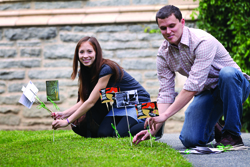It’s a ‘HOOT’
Amanda Vacharat ’06 and Her Co-editor Grow a Mini-literary Magazine

Amanda Vacharat ’06 (left) and Dorian Geisler give a HOOT about poetry while visiting Swarthmore. Photo by Laurence Kesterson
Though Swarthmore is remarkable for its blossom-bedecked grounds, poems sprouting from the fertile soilare a sight seldom seen. But poetry indeed was popping up amongst the flowers last fall, when Amanda Vacharat ’06 and her partner Dorian Geisler staged a stealth operation-cum-poetry invasion of campus.
The couple are co-founders of HOOT, a literary magazine in postcard form that publishes an issue (a postcard containing one poem) each month. Part of their outreach is to plant wooden dowels with copies of HOOT attached in places where the literary-minded lurk, usually bookstores or cafes.
“You’ve seen how quirky Swarthmore is,” says Vacharat. Planting poems all over campus “fits right in.”
One person who took notice was Peter Schmidt, William R. Kenan Jr. Professor of English Literature. After spotting a postcard sprout, he invited Vacharat and Geisler to campus this spring to speak to his Modern American Poetry class and to lead an evening workshop on how to write microfiction—fiction that is only a couple hundred words long.
Vacharat, a former theater and psychobiology major, and Geisler, a University of California–Berkeley philosophy and creative writing graduate who also earned an MFA at the University of Iowa, met in 2010 at a Swarthmore wedding. They launched HOOT in 2011, sharing the editing duties, and with Vacharat serving as artistic director. “I do most of the artwork,” she says, “but we hope to soon create a network between writers and artists.”
Instead of a multipage literary magazine, they chose the postcard format, she says, “because you can slip postcards into the everyday scene without causing distress. We wanted to take our cues from the Internet with its brevity, shareability, and mixed media.”
They chose the title HOOT, says Vacharat, because it represents “an unexpected sound, something small that you would hear in the dark.”
With about 500 subscribers and growing, HOOT has caught on with “young people to retirees,” mostly in the United States. HOOT ’s online presence is even greater—with more than 80,000 page views. “You can’t underestimate the power of social media and online media,” Geisler says.
Though their online edition is turning heads, Vacharat says she prefers the tangibility of print. But it’s been hard to place the magazine in a traditional retail setting, she says, “because a postcard can’t fit into a magazine rack.” The pair plan to print a themed boxed set of HOOT postcards that they hope big-box bookstores like Barnes & Noble will snap up.
Besides paying to host the website, Geisler and Vacharat spend $45 per month to print 1,000 postcards. Subscriptions are $14 per year, and poets can submit two submissions for $2 online or for free if snail mailed.
To ensure HOOT ’s survival, the co-editors are filing paperwork for nonprofit status so they can apply for grants and accept donations. And they’ve taken on an associate editor and two long-distance collaborators, one of whom will lead a new pen-pal initiative.
While growing the HOOT presence—workshops like the microfiction one they led at Swarthmore and setting up a table at the Association of Writers and Writing Programs Annual Conference and Book Fair each spring help with that—they’re keeping their day jobs. Geisler is an adjunct professor at Arcadia University and Chestnut Hill College, while Vacharat works as a standardized patient at Philadelphia-area medical schools.
As a standardized patient, she uses her acting skills—providing medical students practice with patient interaction. Vacharat may portray a daughter who’s just been presented CT scans indicating her mother has terminal cancer. The doctor-in-training has to break the news to her and deal with her emotional reaction. Or she may exhibit disease symptoms—such as appendicitis—that the medical student then has to diagnose.
“It’s structured improv,” she says. “You can say the same line in so many ways based on emotion.”
This spring she applied for a low-residency MFA, with the ambition of becoming a children’s picture-book author. She likes the genre because “it’s where art and words come together.”
While partnering on HOOT, the couple also is co-writing a young-adult novel. “Writing a novel with two people is not easier than having one person write it,” says Geisler with a grin. “But it’s a great learning process.”
Click here to learn more about HOOT
 Email This Page
Email This Page